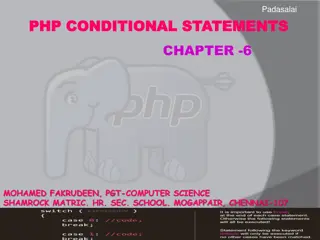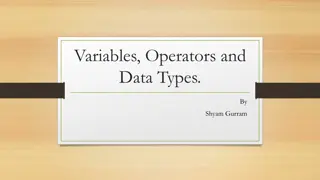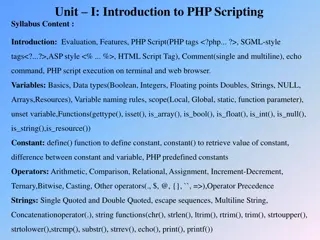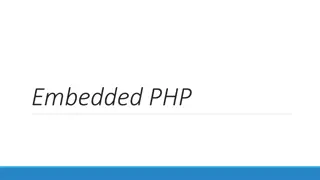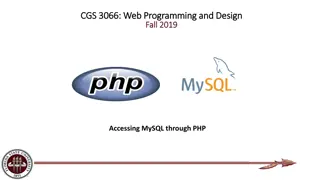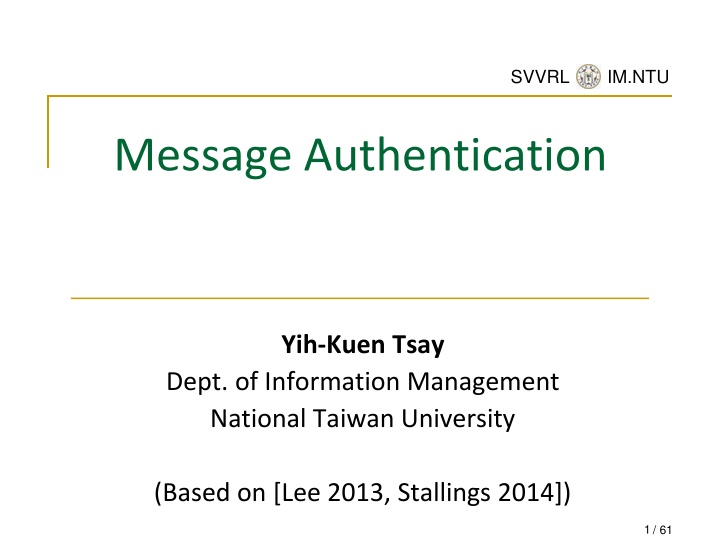
Message Authentication and Security Functions at National Taiwan University
Explore the requirements and functions of message authentication, hash functions, encryption, and key wrapping as outlined by Yih-Kuen Tsay from the Department of Information Management at National Taiwan University. Understand the importance of authenticating messages to prevent attacks in networked communications. Discover how hash functions, message encryption, and message authentication codes play vital roles in ensuring message integrity and authenticity. Gain insights into different types of attacks such as disclosure, traffic analysis, masquerading, and more, and learn about the significance of verifying received messages to protect against such threats.
Download Presentation

Please find below an Image/Link to download the presentation.
The content on the website is provided AS IS for your information and personal use only. It may not be sold, licensed, or shared on other websites without obtaining consent from the author. If you encounter any issues during the download, it is possible that the publisher has removed the file from their server.
You are allowed to download the files provided on this website for personal or commercial use, subject to the condition that they are used lawfully. All files are the property of their respective owners.
The content on the website is provided AS IS for your information and personal use only. It may not be sold, licensed, or shared on other websites without obtaining consent from the author.
E N D
Presentation Transcript
SVVRL @ IM.NTU Message Authentication Yih-Kuen Tsay Dept. of Information Management National Taiwan University (Based on [Lee 2013, Stallings 2014]) 1 / 61
SVVRL @ IM.NTU Outline Message authentication requirements Message authentication functions Requirements for message authentication codes Security of MACs MACs based on hash functions (HMAC) MACs based on block ciphers (DAA and CMAC) Authenticated encryption (CCM and GCM) Key Wrapping Pseudorandom number generation using hash functions and MACs Yih-Kuen Tsay (IM.NTU) IS 2015: Message Authentication 2 / 61
SVVRL @ IM.NTU Authentication Requirements Attacks in networked communications Disclosure Traffic analysis Masquerade Content modification Sequence modification Timing modification Source repudiation Destination repudiation Message authentication verifies that received messages come from the alleged source and have not been altered, against Attacks 3-6 (and 7 partly). 1. 2. 3. 4. 5. 6. 7. 8. Yih-Kuen Tsay (IM.NTU) IS 2015: Message Authentication 3 / 61
SVVRL @ IM.NTU Message Authentication Functions Hash function A function that maps a message of any length into a fixed-length hash value, which serves as the authenticator Two levels of functionality: Lower level There must be some sort of function that produces an authenticator Message encryption The ciphertext of the entire message serves as its authenticator Message authentication code (MAC) A function of the message and a secret key that produces a fixed-length value that serves as the authenticator Higher level Use the lower-level function as a primitive in an authentication protocol that enables a receiver to verify the authenticity of a message Yih-Kuen Tsay (IM.NTU) IS 2015: Message Authentication 4 / 61
SVVRL @ IM.NTU Functions to Produce an Authenticator Hash function: A function that maps a message of any length into a fixed-length hash value, which serves as the authenticator. Message encryption: The ciphertext of the entire message serves as its authenticator. Message authentication code (MAC): A public function of the message and a secret key that produces a fixed-length value that serves as the authenticator. Yih-Kuen Tsay (IM.NTU) IS 2015: Message Authentication 5 / 61
SVVRL @ IM.NTU Message Encryption Symmetric encryption Public-key encryption Yih-Kuen Tsay (IM.NTU) IS 2015: Message Authentication 6 / 61
SVVRL @ IM.NTU Symmetric Encryption: Confidentiality and Authentication Source Destination M E D M K K E(K,M) Yih-Kuen Tsay (IM.NTU) IS 2015: Message Authentication 7 / 61
SVVRL @ IM.NTU Confidentiality and Authentication Implications of Message Encryption Symmetric encryption A B: E(K,M) Provides confidentiality Only A and B share K Provides a degree of authentication Could come only from A Has not been altered in transit Requires some formatting/redundancy Does not provide signature Receiver could forge message Sender could deny message Yih-Kuen Tsay (IM.NTU) IS 2015: Message Authentication 8 / 61
SVVRL @ IM.NTU Symmetric Encryption (cont.) Suppose M can be any bit pattern. There is no way to determine automatically, at the destination, whether an incoming message is the ciphertext of a legitimate message. Thus, in general, we require that only a small subset of all possible bit patterns is considered legitimate plaintext. In that case, any spurious ciphertext is unlikely to produce legitimate plaintext. Yih-Kuen Tsay (IM.NTU) IS 2015: Message Authentication 9 / 61
SVVRL @ IM.NTU Symmetric Encryption (cont.) For example, suppose that we are transmitting messages using Caesar cipher with a shift of one (K=1). A sends the following legitimate ciphertext ipxbsfzpv B decrypts to produce the following plaintext howareyou A simple frequency analysis confirms that this message has the profile of ordinary English. Yih-Kuen Tsay (IM.NTU) IS 2015: Message Authentication 10 / 61
SVVRL @ IM.NTU Symmetric Encryption (cont.) On other hand, if an opponent generates the following random sequence of letters. zuvrsoevgqxlzw It decrypts to ytuqrndufpwkyv which does not fit the profile of ordinary English. Yih-Kuen Tsay (IM.NTU) IS 2015: Message Authentication 11 / 61
SVVRL @ IM.NTU Symmetric Encryption (cont.) It may be difficult to determine automatically if incoming ciphertext decrypts to intelligible plaintext. If the plaintext is, say, a binary object file or digitized images, determination of properly formed and therefore authentic plaintext may be difficult. One solution to this problem is to force the plaintext to have some structure that is easily recognized but that cannot be replicated without recourse to the encryption function. For example, we could append an error-detecting code, also known as a frame check sequence (FCS) or checksum, to each message before encryption. Yih-Kuen Tsay (IM.NTU) IS 2015: Message Authentication 12 / 61
SVVRL @ IM.NTU Internal Error Control Source M M || E F(M) K E(K,M||F(M)) F F M D Compare F(M) K Destination Yih-Kuen Tsay (IM.NTU) IS 2015: Message Authentication 13 / 61
SVVRL @ IM.NTU External Error Control Source || M E M K E(K,M) F D M F F(M) K Compare Destination F(E(K,M)) Yih-Kuen Tsay (IM.NTU) IS 2015: Message Authentication 14 / 61
SVVRL @ IM.NTU TCP Segment 4 31 16 0 10 Bit: Source port Destination Sequence number Acknowledge number Flags Windows Data offsetReserved Checksum Urgent pointer Options + padding Applications data A TCP segment has a meaningful header, which can serve as the needed structuring of the plaintext for authentication. Yih-Kuen Tsay (IM.NTU) IS 2015: Message Authentication 15 / 61
SVVRL @ IM.NTU Public-Key Encryption: Confidentiality Source Destination M E D M PRb PUb E(PUb, M) Yih-Kuen Tsay (IM.NTU) IS 2015: Message Authentication 16 / 61
SVVRL @ IM.NTU Public-Key Encryption: Authentication and Signature Source Destination M E D M PUa PRa E(PRa, M) Yih-Kuen Tsay (IM.NTU) IS 2015: Message Authentication 17 / 61
SVVRL @ IM.NTU Public-Key Encryption: Confidentiality, Authentication, and Signature Source M E E E(PUb,E(PRa,M)) PRa E(PRa, M) PUb D D M E(PRa, M) PRb PUa Destination Yih-Kuen Tsay (IM.NTU) IS 2015: Message Authentication 18 / 61
SVVRL @ IM.NTU Public-Key Encryption: Confidentiality, Authentication, and Signature (cont.) The disadvantage of this approach is that the public-key algorithm, which is complex, must be exercised four times rather than two in each communication. Yih-Kuen Tsay (IM.NTU) IS 2015: Message Authentication 19 / 61
SVVRL @ IM.NTU Confidentiality and Authentication Implications of Message Encryption (cont.) Public-key encryption, using the public key PUbof B, i.e., A B: E(PUb,M) Provides confidentiality Only B has PRbto decrypt Provides no authentication Any party could use PUbto encrypt message and claim to be A Yih-Kuen Tsay (IM.NTU) IS 2015: Message Authentication 20 / 61
SVVRL @ IM.NTU Confidentiality and Authentication Implications of Message Encryption (cont.) Public-key encryption, using the private key PRa of A, i.e., A B: E(PRa, M) Provides authentication and signature Only A has PRato encrypt Has not been altered in transit Require some formatting/redundancy Any part can use PUato verify signature Yih-Kuen Tsay (IM.NTU) IS 2015: Message Authentication 21 / 61
SVVRL @ IM.NTU Confidentiality and Authentication Implications of Message Encryption (cont.) Public-key encryption, using both PUband PRa, i.e., A B: E(PUb, E(PRa, M)) Provides confidentiality because of PUb. Provides authentication and signature because of PRa. Yih-Kuen Tsay (IM.NTU) IS 2015: Message Authentication 22 / 61
SVVRL @ IM.NTU Message Authentication Code (MAC) An alternative authentication technique involves the use of a secret key to generate a small fixed- size block of data, known as a cryptographic checksum or MAC, that is appended to the message. When A sends a message to B, it calculates the MAC=C(K,M), where K is the secret key. The message plus MAC are send to B. B performs the same calculation on the received message to generate new MAC which is compared to the received MAC. Yih-Kuen Tsay (IM.NTU) IS 2015: Message Authentication 23 / 61
SVVRL @ IM.NTU Message Authentication Source Destination C M M || Compare K K C(K,M) C Yih-Kuen Tsay (IM.NTU) IS 2015: Message Authentication 24 / 61
SVVRL @ IM.NTU MAC (cont.) Assume that only the receiver and sender know the identity of the secret key, and if the received MAC matches the calculated MAC. The receiver is assured that the message has not been altered. The receiver is assured that the message is from the alleged sender. If the message includes a sequence number, then the receiver can be assured of the proper sequence because an attacked cannot successfully alter the sequence number. Yih-Kuen Tsay (IM.NTU) IS 2015: Message Authentication 25 / 61
SVVRL @ IM.NTU MAC (cont.) A MAC function is similar to encryption. One difference is that the MAC algorithm need not be reversible, as it must for decryption. It turns out that because of the mathematical properties of the authentication function, it is less vulnerable to being broken than encryption. Yih-Kuen Tsay (IM.NTU) IS 2015: Message Authentication 26 / 61
SVVRL @ IM.NTU Message Authentication and Confidentiality; Authentication Tied to Plaintext Source M || E K1 K2 C E(K2,[M||C(K1,M)]) C D M Compare K1 C(K1,M) K2 Destination Yih-Kuen Tsay (IM.NTU) IS 2015: Message Authentication 27 / 61
SVVRL @ IM.NTU Message Authentication and Confidentiality; Authentication Tied to Ciphertext Source M || E K1 K2 C E(K2,M) D M C K2 Compare K1 C(K1,E(K2,M)) Destination Yih-Kuen Tsay (IM.NTU) IS 2015: Message Authentication 28 / 61
SVVRL @ IM.NTU Where a MAC Is Used There are a number of applications in which the same message is broadcast to a number of destinations. E.g., notification to network users, alarm signal in a military control center, etc. Another possible scenario is an exchange in which one side has a heavy load and cannot afford the time to decrypt all incoming messages. Authentication of a computer program in plaintext is an attractive service. Yih-Kuen Tsay (IM.NTU) IS 2015: Message Authentication 29 / 61
SVVRL @ IM.NTU Where a MAC Is Used (cont.) For some applications (e.g., SNMP), it may not be of concern to keep messages secret, but it is important to authenticate messages. Separation of authentication and confidentiality functions affords architectural flexibility. Note that the MAC does not provide a digital signature because both sender and receiver share the same key. Yih-Kuen Tsay (IM.NTU) IS 2015: Message Authentication 30 / 61
SVVRL @ IM.NTU Basic Uses of a MAC A B: M C(K,M) Provides authentication: only A and B share K A B: E(K2, [M C(K1,M)]) Provides authentication: only A and B share K1 Provides confidentiality: only A and B share K2 A B: C(K1,E(K2,M)) Provides authentication: using K1 Provides confidentiality: using K2 Yih-Kuen Tsay (IM.NTU) IS 2015: Message Authentication 31 / 61
SVVRL @ IM.NTU Message Authentication Codes (MACs) A MAC, also known as a cryptographic checksum, is generated by a function C of T=C(K,M) where M is a variable-length message, K is a secret key shared only by sender and receiver and C(K,M) is the fixed-length authenticator. In general, the MAC function is a many-to-one function. If an n-bit MAC is used, then there are 2npossible MACs, whereas there are N possible messages with N 2n. Yih-Kuen Tsay (IM.NTU) IS 2015: Message Authentication 32 / 61
SVVRL @ IM.NTU Discovering a Key If confidentiality is not employed, the opponent has access to plaintext messages and their associated MACs. Suppose k>n; that is, the key (guess) size is greater than the MAC size. Given a known M1and T1=C(K1,M1), the cryptanalyst can perform Ti=C(Ki,M1) for all possible key values. At least one key is guaranteed to produce a match. On average, a total of 2k/2n=2(k-n)keys will produce a match. Yih-Kuen Tsay (IM.NTU) IS 2015: Message Authentication 33 / 61
SVVRL @ IM.NTU Discovering a Key (cont.) Thus, the opponent must iterate the attack. Round 1 Given: M1, T1=C(K,M1) Compute Ti=C(Ki,M1) for all 2kkeys Number of matches 2(k-n) Round 2 Given: M2, MAC2=C(K,M2) Compute Ti=C(Ki,M2) for the remaining 2(k-n)keys Number of matches 2(k-2n) On average, rounds will be needed if k= n. Yih-Kuen Tsay (IM.NTU) IS 2015: Message Authentication 34 / 61
SVVRL @ IM.NTU Discovering a Key (cont.) For example, if an 80-bit key is used and the MAC is 32-bit long, then the first round will produce about 248possible keys. The second round will narrow the possible keys to about 216possibilities. The third round will produce only the single key, which must be the one used by the sender. Yih-Kuen Tsay (IM.NTU) IS 2015: Message Authentication 35 / 61
SVVRL @ IM.NTU A Simple But Weak MAC Let M=(X1 X2 Xm) be a message that is treated as a concatenation of 64-bit blocks Xi. Then define (M)= X1 X2 Xm MAC(K,M)=E(K, (M)) where is the exclusive-OR(XOR) operation and the encryption algorithm is DES in electronic codebook mode. Thus, the key length is 56 bits and the MAC length is 64 bits. Yih-Kuen Tsay (IM.NTU) IS 2015: Message Authentication 36 / 61
SVVRL @ IM.NTU A Simple But Weak MAC (cont.) If an opponent observes {M MAC(K,M)}, a brute- force attempt to determine K will require at least 256encryptions. But the opponent can attack the system by replacing X1through Xm-1with any desired values Y1through Ym-1and Xmwith Ym, where Ymis Ym=Y1 Y2 Ym-1 (M) That is, the fabricated plaintext M = Y1 Y2 Ym-1 [Y1 Y2 Ym-1 (M)] Note that Y1 Y2 Ym-1 [Y1 Y2 Ym-1 (M)] = (M) Yih-Kuen Tsay (IM.NTU) IS 2015: Message Authentication 37 / 61
SVVRL @ IM.NTU A Simple But Weak MAC (cont.) The opponent can now concatenate the new message, which consists of Y1through Ym, with the original MAC to form a message that will accepted as authentic by the receiver. That is, the following is sent to the receiver: M E(K, (M)) where M = Y1 Y2 Ym-1 [Y1 Y2 Ym-1 (M)] With this tactic, any message of length 64 (m-1) bits can be fraudulently inserted. Yih-Kuen Tsay (IM.NTU) IS 2015: Message Authentication 38 / 61
SVVRL @ IM.NTU Properties of a MAC Assume that an opponent knows the MAC function C but does not know K. Then the MAC function should have the following properties: If an opponent observes M and C(K,M), it should be computationally infeasible for the opponent to construct a message M such that C(K,M )=C(K,M). C(K,M) should be uniformly distributed in the sense that for randomly chosen messages, M and M , the probability that C(K,M)=C(K,M ) is 2-n, where n is the number of bits in the MAC. Let M be equal to some known transformation on M. That is, M =f(M). In that case, Pr[C(K,M)=C(K,M )]=2-n. Yih-Kuen Tsay (IM.NTU) IS 2015: Message Authentication 39 / 61
SVVRL @ IM.NTU Brute-Force Attack on a MAC Computation resistance: Given one or more text- MAC pairs (xi, C(K,xi)), it is computationally infeasible to compute any text-MAC pair (x, C(K,x)) for any new input x xi. The level of effort for brute-force attack on a MAC algorithm can be expressed as min (2k, 2n), where k is the length of key and n is the length of the MAC. It would appear reasonable to require that the key length and MAC length satisfy a relationship such as min(k,n)>N, where N is perhaps in the range of 128 bits. Yih-Kuen Tsay (IM.NTU) IS 2015: Message Authentication 40 / 61
SVVRL @ IM.NTU Cryptanalysis Attacks Cryptanalysis attacks on hash functions and MAC algorithms seek to exploit some property of the algorithm to perform some attack other than an exhaustive search. An ideal hash of MAC algorithm will require a cryptanalytic effort greater than or equal to the brute-force attack. Yih-Kuen Tsay (IM.NTU) IS 2015: Message Authentication 41 / 61
SVVRL @ IM.NTU Keyed Hash Functions as MACs Want a MAC based on a hash function because hash functions are generally faster code for crypto hash functions widely available Hash includes a key along with message Original proposal: KeyedHash = Hash(Key Message) some weaknesses were found with this Eventually led to development of HMAC Yih-Kuen Tsay (IM.NTU) IS 2015: Message Authentication 42 / 61
SVVRL @ IM.NTU HMAC There has been increased interest in developing an MAC derived from a cryptographic hash code. The approach that has received the most support is HMAC. HMAC has been chosen as the mandatory-to- implement HMAC for IP security. Yih-Kuen Tsay (IM.NTU) IS 2015: Message Authentication 43 / 61
SVVRL @ IM.NTU HMAC Design Objectives To use, without modifications, available hash functions. To allow for easy replaceability of the embedded hash function in case faster or more secure hash functions are found or required. To preserve the original performance of the hash function without incurring a significant degradation. To use and handle keys in a simple way. To have a well understood cryptographic analysis of the strength of the authentication mechanism. Yih-Kuen Tsay (IM.NTU) IS 2015: Message Authentication 44 / 61
SVVRL @ IM.NTU HMAC Specified as Internet standard RFC 2104 Uses hash function on the message: HMACK= Hash[(K+ opad) Hash[(K+ ipad) M ]] where K+is the key padded out to size, opad, ipad are specified padding constants Overhead is just 3 more hash calculations than the message needs alone Any hash function can be used E.g., MD5, SHA-1, RIPEMD-160 Yih-Kuen Tsay (IM.NTU) IS 2015: Message Authentication 45 / 61
SVVRL @ IM.NTU ipad=00110110 repeated b/8 times opad=01011010 repeated b/8 times Yih-Kuen Tsay (IM.NTU) IS 2015: Message Authentication 46 / 61
SVVRL @ IM.NTU Efficient implementation of HMAC Yih-Kuen Tsay (IM.NTU) IS 2015: Message Authentication 47 / 61
SVVRL @ IM.NTU HMAC Security Proved security of HMAC relates to that of the underlying hash algorithm Attacking HMAC requires either: brute force attack on key used birthday attack (but since keyed would need to observe a very large number of messages) Choose hash function used based on speed verses security constraints Attacking HMAC, the attacker cannot generate message/code pairs offline because the attacker does not know K. Yih-Kuen Tsay (IM.NTU) IS 2015: Message Authentication 48 / 61
SVVRL @ IM.NTU Data Authentication Algorithm Yih-Kuen Tsay (IM.NTU) IS 2015: Message Authentication 49 / 61
SVVRL @ IM.NTU L=E(K,0n), K1=Lx, K2=Lx2 CMAC overview IS 2015: Message Authentication Yih-Kuen Tsay (IM.NTU) 50 / 61







